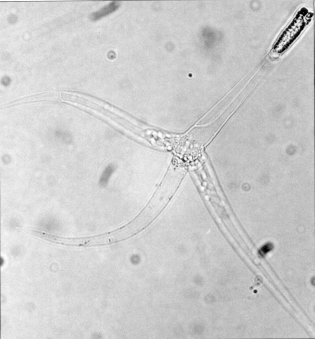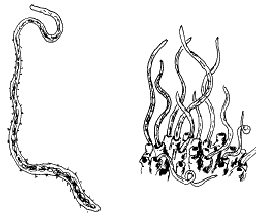
Oligochaeta is a subclass of soft-bodied animals in the phylum Annelida, which is made up of many types of aquatic and terrestrial worms, including all of the various earthworms. Specifically, oligochaetes comprise the terrestrial megadrile earthworms, and freshwater or semiterrestrial microdrile forms, including the tubificids, pot worms and ice worms (Enchytraeidae), blackworms (Lumbriculidae) and several interstitial marine worms.

Myxobolus cerebralis is a myxosporean parasite of salmonids that causes whirling disease in farmed salmon and trout and also in wild fish populations. It was first described in rainbow trout in Germany in 1893, but its range has spread and it has appeared in most of Europe, the United States, South Africa, Canada and other countries from shipments of cultured and wild fish. In the 1980s, M. cerebralis was found to require a tubificid oligochaete to complete its life cycle. The parasite infects its hosts with its cells after piercing them with polar filaments ejected from nematocyst-like capsules. This infects the cartilage and possibly the nervous tissue of salmonids, causing a potentially lethal infection in which the host develops a black tail, spinal deformities, and possibly more deformities in the anterior part of the fish.

Enchytraeidae is a family of microdrile oligochaetes. They resemble small earthworms and include both terrestrial species known as potworms that live in highly organic terrestrial environments, as well as some that are marine. The peculiar genus Mesenchytraeus is known as "ice worms", as they spend the majority of their lives within glaciers, only rising to the surface at certain points in the summer. Enchytraeidae also includes the Grindal Worm, which is commercially bred as aquarium fish food.

The Clitellata are a class of annelid worms, characterized by having a clitellum – the 'collar' that forms a reproductive cocoon during part of their life cycles. The clitellates comprise around 8,000 species. Unlike the class of Polychaeta, they do not have parapodia and their heads are less developed.

Tubifex is a cosmopolitan genus of tubificid annelids that inhabits the sediments of lakes, rivers and occasionally sewer lines. At least 13 species of Tubifex have been identified, with the exact number not certain, as the species are not easily distinguishable from each other.

Chaetogaster is a genus belonging to the segmented worms (Annelida). It is classified in the family Naididae in the order Oligochaeta. These are ca. 2–25 mm long transparent worms that are very common in fresh water and often form chains of individuals through asexual multiplication.

Olavius algarvensis is a species of gutless oligochaete worm in the family Tubificidae which depends on symbiotic bacteria for its nutrition.
Eustrongylidosis is a parasitic disease that mainly affects wading birds worldwide; however, the parasite's complex, indirect lifecycle involves other species, such as aquatic worms and fish. Moreover, this disease is zoonotic, which means the parasite can transmit disease from animals to humans. Eustrongylidosis is named after the causative agent Eustrongylides, and typically occurs in eutrophicated waters where concentrations of nutrients and minerals are high enough to provide ideal conditions for the parasite to thrive and persist. Because eutrophication has become a common issue due to agricultural runoff and urban development, cases of eustrongylidosis are becoming prevalent and hard to control. Eustrongylidosis can be diagnosed before or after death by observing behavior and clinical signs, and performing fecal flotations and necropsies. Methods to control it include preventing eutrophication and providing hosts with uninfected food sources in aquaculture farms. Parasites are known to be indicators of environmental health and stability, so should be studied further to better understand the parasite's lifecycle and how it affects predator-prey interactions and improve conservation efforts.
Heterodrilus flexuosus is a species of oligochaete worm, first found in Belize, on the Caribbean side of Central America.
Heterodrilus rarus is a species of oligochaete worm, first found in Belize, on the Caribbean side of Central America.
Heterodrilus modestus is a species of oligochaete worm, first found in Belize, on the Caribbean side of Central America.
Coralliodrilus rugosus is a species of clitellate oligochaete worm, first found in Belize, on the Caribbean side of Central America. It is found in a range of sediments near the limits of saline groundwater, but never below tidal zones.
Inanidrilus reginae is a species of clitellate oligochaete worm in the family Naididae. It was first found in Belize, on the Caribbean side of Central America. It lives in subtidal sand with seagrass.
Olavius vacuus is a species of oligochaete worm, first found in Belize, on the Caribbean side of Central America.
Thalassodrilides bruneti is a species of oligochaete worm, first found in Belize, on the Caribbean side of Central America.
Limnodriloides anxius is a species of clitellate oligochaete worm, first found in Belize, on the Caribbean side of Central America.

Limnodrilus hoffmeisteri, also known as red worm, is one of the most widespread and abundant oligochaetes in the world.
Smithsonidrilus is a genus of oligochaete worms.
Phallodrilinae is a subfamily of clitellate oligochaete worms.
Coralliodrilus is a genus of clitellate oligochaete worms.













